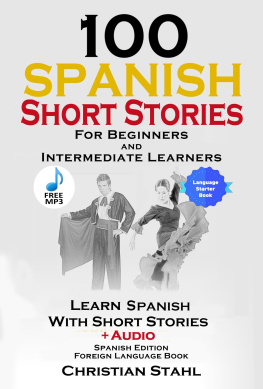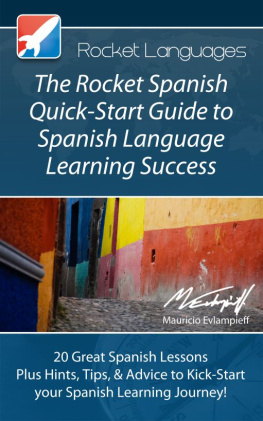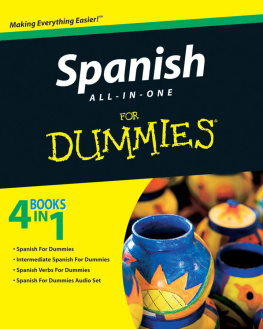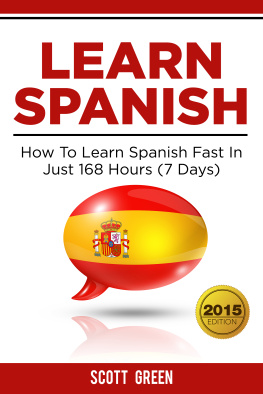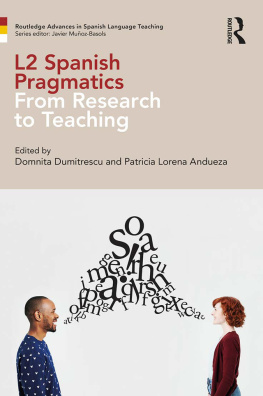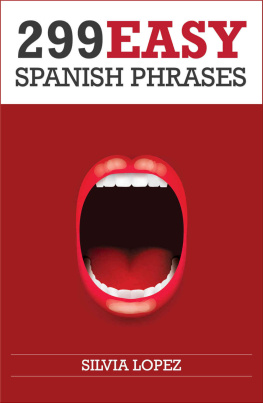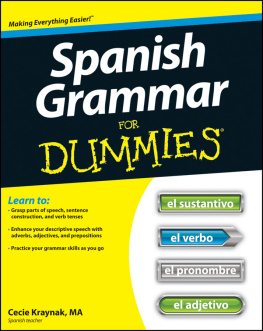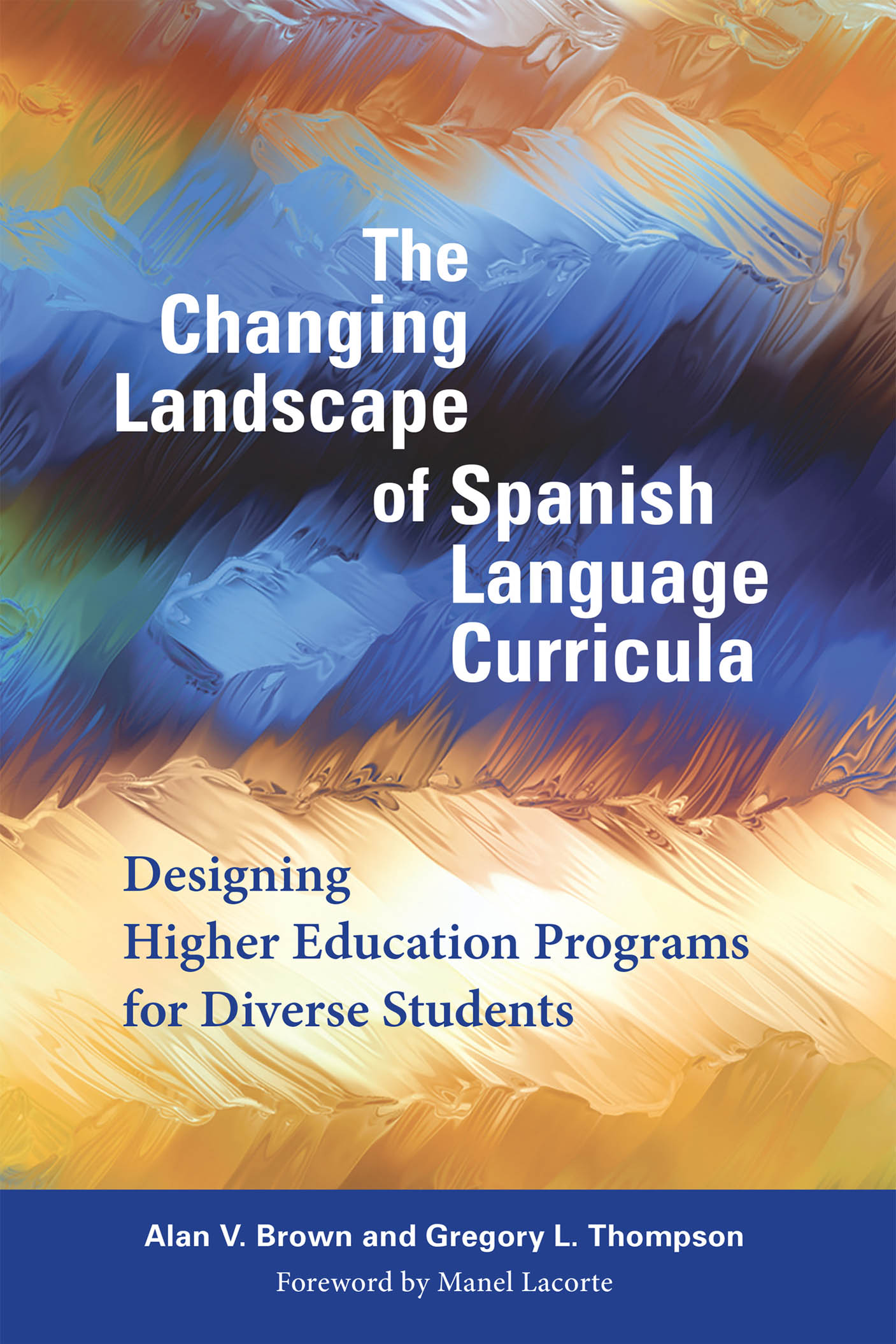the changing landscape of spanish language curricula
the changing landscape of spanish language curricula
Designing Higher Education Programs for Diverse Students
Alan V. Brown and Gregory L. Thompson
Foreword by Manel Lacorte

2018 Georgetown University Press. All rights reserved. No part of this book may be reproduced or utilized in any form or by any means, electronic or mechanical, including photocopying and recording, or by any information storage and retrieval system, without permission in writing from the publisher.
The publisher is not responsible for third-party websites or their content. URL links were active at time of publication.
Library of Congress Cataloging-in-Publication Data
Names: Brown, Alan V., author. | Thompson, Gregory L., author.
Title: The Changing Landscape of Spanish Language Curricula : Designing Higher Education Programs for Diverse Students / Alan V. Brown and Gregory L. Thompson.
Description: Washington, DC : Georgetown University Press, 2018. | Includes bibliographical references and index.
Identifiers: LCCN 2017035595| ISBN 9781626165731 (hardcover : alk. paper) | ISBN 9781626165748 (pbk. : alk. paper) | ISBN 9781626165755 (ebook)
Subjects: LCSH: Spanish languageStudy and teaching (Higher)United States. | Universities and collegesCurriculaUnited States.
Classification: LCC PC4068.U5 B76 2018 | DDC 468.0071/173dc23
LC record available at https://lccn.loc.gov/2017035595
This book is printed on acid-free paper meeting the requirements of the American National Standard for Permanence in Paper for Printed Library Materials.
19 18 9 8 7 6 5 4 3 2 First printing
Printed in the United States of America
Cover design by Martha Madrid.
contents
by Manel Lacorte
illustrations
Figures
Tables
foreword
Manel Lacorte
University of Maryland
The first two decades of the twenty-first century have been particularly positive for the teaching of Spanish as a foreign language (FL) or second language (L2) throughout the world, as should be expected in light of the ongoing consolidation of Spanish as an international language of culture, communication, business, and knowledge.
In the case of the United States, the teaching and learning of Spanish have enjoyed a quite extensive tradition since the early sixteenth century, as the authors of this volume skillfully describe as part of their effort to contextualize the present state of Spanish in US education. More than five hundred years after the first words of Spanish were spoken on the coast of what is now Florida, this language is now an academic subject for over 7.5 million students (out of a total of about 11 million) in the K12 formal US education system, and about 800,000 learners in postsecondary centersmore than 50 percent of all L2 enrollments in this context. In addition, the United States is one of the most important research centers for the teaching, acquisition, and other applications of Spanish as an FL, L2, or heritage language (HL), with more than two hundred doctoral degree programs.
Strengthening the balance between a healthy demand for Spanish education at all levelsfor K16 and beyondand a sizable body of high-quality research on Spanish as an FL/L2 will be an essential endeavor in the years ahead, considering possible trends that could affect L2 education, such as reductions in L2 requirements (especially in the natural and social sciences), more pressure on students to select options with more immediate financial promise, competition with other disciplines (e.g., computer sciences and information and communication technology), and a lack of institutional and/or financial support. Because the future of the humanities in US higher educationincluding L2 teaching and learningdoes not look much more promising, it is crucial for the field of Spanish education to go beyond research focused on internal or external L2 learning processes and to devote more attention to larger and more complex institutional, social, cultural, and ideological issues in the teaching of Spanish as a FL/L2.
It is precisely for this reason that Alan Brown and Gregory Thompsons book will indeed become a reference for students, instructors, researchers, and administrators with interest in macroprogrammatic issues directly linked to Spanish university programs in the US. Drawing upon their own extensive experience and high-quality research, these authors have written a quite needed, exciting, and insightful analysis of programmatic and curricular trends, challenges, and opportunities in Spanish language education at the postsecondary level in this country, with the objective of providing realistic and valuable recommendations for the twenty-first century.
Brown and Thompson have keenly examined a significant amount of published and unpublished documents from a variety of sources, always aware of the place that Spanish has as a second, rather than as a foreign, language in many communities throughout the US. Precisely because of the distinctive history of Spanish in this country, and its current status as the language of the largest minority, the reevaluation of the structures and curricula of most Spanish programs involves challenges related to not only the traditional two-tiered configurationlanguages versus literaturesand emphasis on achieving native-like competency in the language, but also the unique position of Spanish in the US, and the place that Spanish programs should have within institutions of higher education. Brown and Thompson address these challenges through an intelligent analysis of the historical, sociopolitical, and ideological circumstances that have shaped Spanish in the US, because they believe that these realities could bring about great opportunities for Spanish language curriculum and course syllabus design, materials development, individual and programmatic assessment, and classroom pedagogy in the twenty-first century. As part of their analysis, the authors include topics as diverse as the countrys evolving demographics, the historical and ideological construction of Spanish in the US, the cultural realities of many Spanish-speaking communities throughout the country, and the growing presence of HL learners in US universities due to (1) the overall growth of the Hispanic population and (2) the greater opportunities for Latino students to access higher education.
The need for rethinking and restructuring Spanish programs in the US is not only related to external causes. For decades, L2 departments have faced serious structural and curricular inconsistencies. First, the study of language and the study of literature have been for the most part based on different assumptions and goals. Second, this language-versus-content dichotomy has defined the division between lower- and upper-division courses in the curriculum. At the lower level, the main concern has traditionally been how to implement changing positions about L2 teaching and learning, often through textbooks and multimedia providing very limited and/or unrealistic views of US Spanish-speaking communities. At the upper level, the main stress has generally been on teaching canonical literature and/or culture, focusing on specific periods, geographical areas, and/or renowned authors. While taking into account differences in terms of program size and mission, academic emphasis, and human resources, a third distinction involves, on one hand, the teaching of lower-level courses by graduate teaching assistants, lecturers, or adjuncts following a relatively uniform structure, and on the other hand, the teaching of upper-level courses by tenure-track faculty in a more loosely coordinated structure with fewer hierarchy levels and a less strict chain of command.


